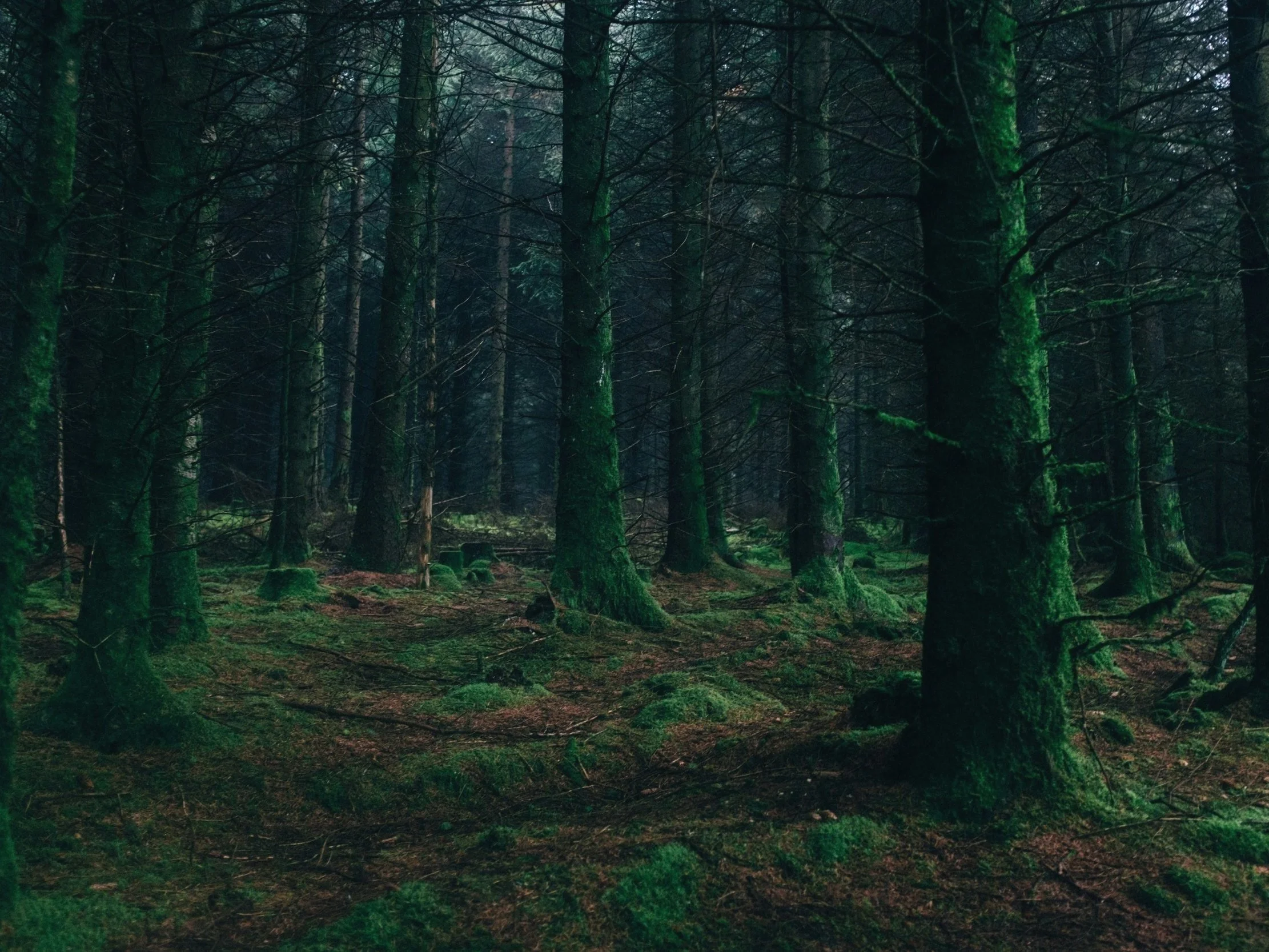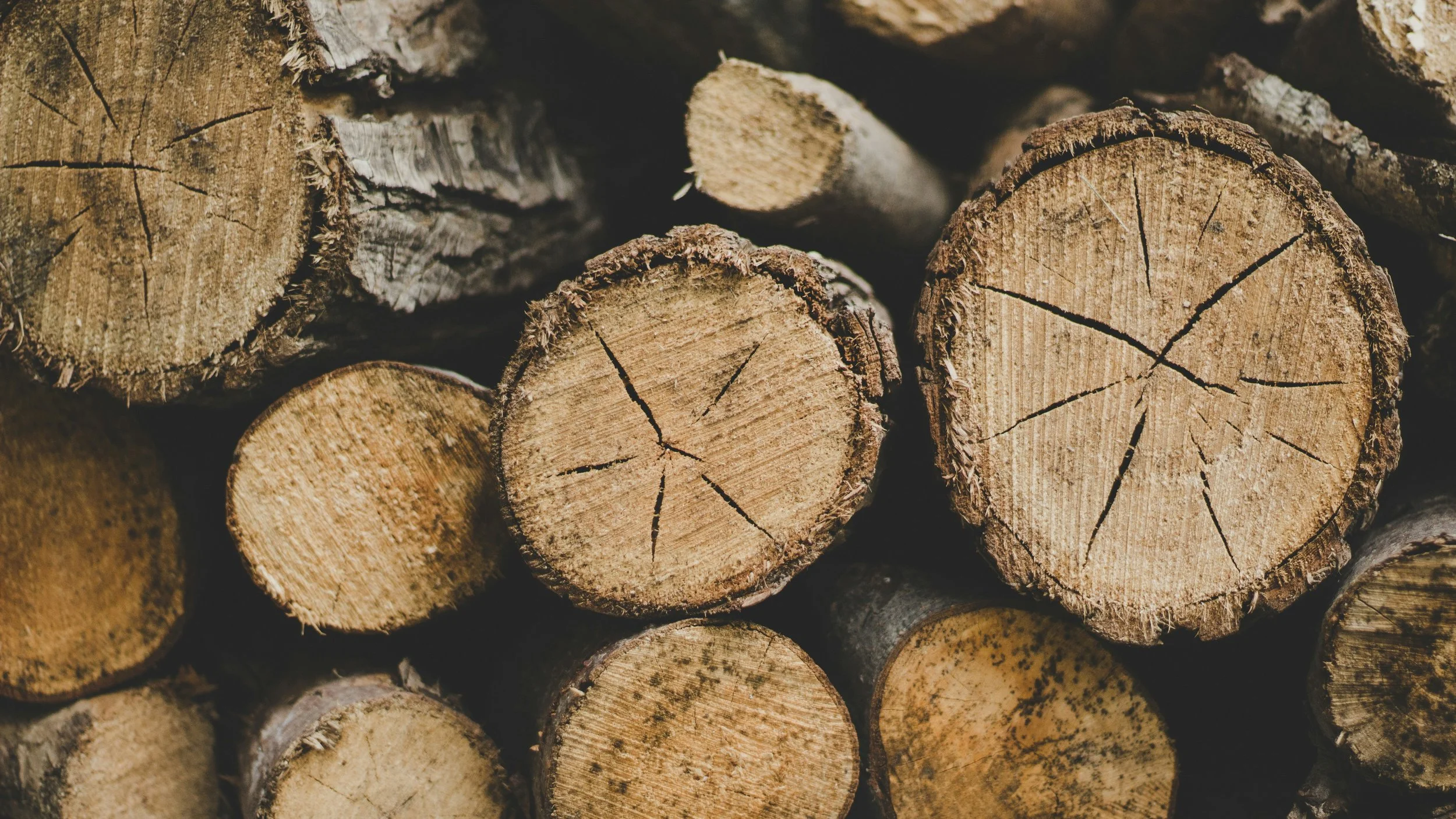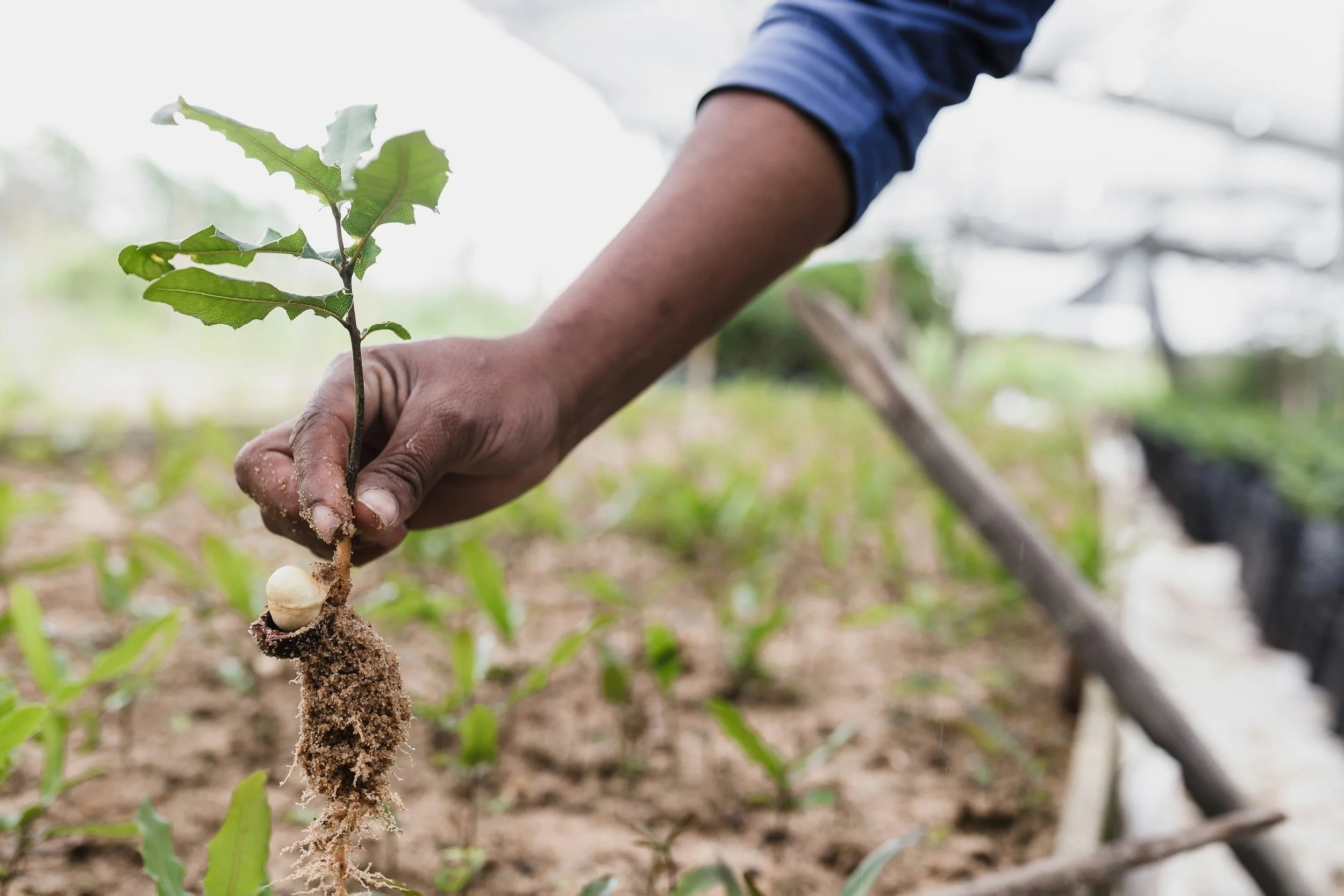Ireland’s fake forests: why our “forests” are not natural
An overhead view of a tightly packed Sitka spruce plantation in Ireland, its dark, uniform canopy concealing ecological silence below. What appears lush from above is in fact a monoculture—planted not for biodiversity, but for profit.
The hidden cost of Ireland’s green illusion
You think you’re walking through a forest. The trees stand tall, rank upon rank, needle-cloaked and dark as ink. The ground beneath your boots is soft with years of fallen pine. But there is no birdsong. No rustle of fox or deer. No sudden flutter in the undergrowth. Only stillness. Only silence. It feels wrong, though you may not yet know why.
This is not a forest.
It is a plantation.
Ireland today wears green like a borrowed garment—beautiful at distance, hollow at the seams. Once, this land was thick with wildwood, woven from oak, ash, birch and yew. A thousand years ago, forests blanketed over 80% of the island. They were not places to be passed through quickly, but to be known slowly—deep, wet, breathing ecosystems. Every inch alive. Every shadow full of meaning.
Now, we have rows.
Sitka spruce, imported from Alaska. Larch from Japan. Pine from Corsica. Fast-growing, tall-standing, uniform. These trees do not belong to the soil they’re rooted in. They were chosen not for their beauty, or the shelter they give, but for how efficiently they can be cut down. Grown like crops. Harvested like wheat.
We call them “forests.” But they are not. A forest is a web—complex, tangled, singing with biodiversity. These plantations are something else entirely.
How Ireland replaced its forests
The story begins with loss. Ireland’s native forests—once dense and mythic—were steadily cut down over centuries, cleared for agriculture, for firewood, for shipbuilding. By the late 1800s, the forest cover had collapsed to a desperate 1%. What followed was not restoration. It was replacement.
In the early 20th century, a decision was made—not to rewild, but to replant. And the trees chosen were not the slow, sprawling species of native memory. They were the quick, utilitarian species of foreign soils: Sitka spruce most of all. They grew tall and straight in poor soil. They could be harvested in a few short decades. To a government focused on timber production, it seemed a perfect solution.
And so, plantations spread across the island, climbing into bogs and peatlands, over once-bare hills, into valleys that had been open to sun and sky for generations. State forestry incentives pushed the expansion, often into marginal land where traditional farming was in decline.
But what grew in place of forests were something else entirely. Unlike native woodlands, these plantations did not evolve in rhythm with the land. Their needles fell thick, turning the soil acidic. Understory plants disappeared. Fungi retreated. Insects starved. The birds stopped coming.
Digital soil thermometer inserted into dry, compacted earth, highlighting the impact of conifer plantations on Irish soil health and biodiversity.
There is a word for this in ecology: ecological impoverishment.
To the untrained eye, a plantation may look like a forest. But to the fox, to the wren, to the mycelial webs beneath the soil, it is barren. No layering. No complexity. No time.
The trees may be alive. But the forest, as an ecosystem, is not.
The damage we don’t see
The harm caused by conifer plantations isn’t always visible. It happens quietly, beneath the surface, beneath the feet.
Dark, dense conifer plantation with moss-covered ground, illustrating the hidden ecological damage and biodiversity loss from monoculture forestry in Ireland.
These trees are water-hungry. Their thirsty roots and dense canopies draw up huge volumes of rainfall and hold it, altering local hydrology. Streams run dry. Bogs—ancient carbon sinks—are drained and degraded. Amphibians vanish. Wetland birds stop nesting.
The soil itself suffers. Acidified by decades of falling needles, its pH drops, and the microbiomes that once thrived belowground begin to collapse. Native species that try to grow are often smothered by the thick mat of pine litter. Their seeds may germinate—but they rarely survive.
And then there are the invasive guests.
These simplified habitats invite others. Deer flourish in the absence of predators, grazing native saplings to the nub. Rabbits overpopulate. Grey squirrels, an introduced species, thrive in conifer woods, outcompeting the dwindling reds. With no ecological balance, the system tips further toward homogeneity.
Even the air is affected. A true forest breathes in carbon and exhales oxygen, but it also hums with the subtle work of sequestration—storing carbon in roots, leaves, humus, and deep, damp peat. Plantations do this poorly. Their short cycles—cutting every 30 or 40 years—mean the carbon is soon released again through logging, transport, and decay. And because many are planted over peat bogs, which must be drained first, the carbon loss often outweighs the gain.
What’s more, these plantations are frequently clear-felled: vast swathes of land cut at once, leaving gaping wounds in the landscape. Hills stripped bare. Rivers choked with silt. Animals fleeing. Wind scouring the raw ground.
To the passerby, these felled sites look like war zones.
And in a way, they are. Not a war fought with fire or gunpowder—but with silence.
Why Ireland’s “reforestation” isn’t what it seems
The language around it has always been slippery. The word “forest” is used in official reports. Percentages of “tree cover” are cited with pride. Ireland is reforesting, they say. We’ve gone from 1% to over 11%. It sounds like healing.
But numbers deceive.
Of that 11%, 9% is made of plantations—uniform stands of exotic species, almost all grown for commercial harvesting. Less than 2% of Ireland’s land is covered in native woodland. And even less of that can be called ancient. The kind of forest where a hawk might nest in a centuries-old oak, where lichens grow that remember the flight of wolves.
To call this progress is to mistake presence for integrity.
A row of trees is not a forest, just as a dammed river is not a living stream. We have settled for the shadow instead of the thing itself. A ghost forest. A simulacrum of nature that profits but does not sustain.
And yet we do not speak of this loudly. The plantations keep expanding. Government grants still incentivize them. Timber remains a lucrative export. The economic story drowns out the ecological one.
But there are voices—soft, persistent—speaking otherwise. Ecologists mapping forgotten woods. Activists protecting old hedgerows. Landowners rewilding acre by acre, planting hazel, alder, rowan. People who still remember what a forest means—not as a resource, but as a relationship.
We are a country haunted by the trees we cut down, and the ones we planted in their place.
Restoring forests beyond rows and profit
So what do we do, in the face of this quiet undoing?
We begin by telling the truth.
Stacked cut logs highlighting industrial timber harvesting, used to illustrate the need to shift forestry practices toward ecological restoration rather than commercial gain.
We name the plantations for what they are—timber farms, not forests. We stop mistaking quantity for quality. We stop celebrating growth that comes at the cost of life. And we listen, deeply, to the land itself.
True reforestation begins with humility. With the recognition that wildness cannot be grown in rows, and that ecosystems are not machines. If we are to restore the forests, we must do more than plant trees. We must restore relationships: between species, between soil and water, between ourselves and the land.
That means planting native trees—oak, ash, hazel, birch. It means giving them time, decades or even centuries. It means protecting the ancient woods that remain, however small. It means tearing up conifers where they choke peatlands and wetlands and letting the bogs breathe again. It means listening to the wisdom of traditional land care, of community forestry, of indigenous knowledge in places like Donegal or the Burren.
It means allowing mess. Complexity. Slowness. Death and decay. Because real forests are not tidy. They do not grow in grids. They are wild, plural, difficult to map. And that is what makes them sacred.
In this work, there is grief—yes. But there is also hope. Because the land wants to heal. Given the chance, it will. Native trees are resilient. Seeds wait for centuries. Streams return when allowed. Life is not easily erased. It lingers.
And so we plant—not just trees, but time. We plant complexity. We plant futures that will outlive us.
Ireland’s real forests are not gone. They are just waiting.
The forgotten roots of Ireland’s lost forests
Not everything dies when the trees are felled.
Even here, in the shadow of monoculture, the land remembers. Beneath the conifers’ acid-dripped litter, the seeds of ancient things lie dormant, waiting. Waiting for light. Waiting for time. Waiting for the weight of industry to lift so they might breathe again.
Because a forest is never truly erased—it is buried.
The old roots sleep beneath the rows, tangled in the dark. Mycelium threads pulse like memory through the soil. Ghosts of oak groves murmur in windless clearings. A bramble creeps through a fence and finds a patch of untouched ground. A jay buries an acorn by instinct alone.
Nature, even when wounded, resists oblivion. It is stubborn like that.
But resistance is not recovery.
The truth is, most of what was lost will not return on its own. The wolves that ran the ridgelines are gone. The cranes that danced in boglight skies have vanished. The knowledge carried by forest elders—human and non-human alike—has been scattered like ash. A thousand years of balance, undone in barely a century.
And yet, the land does not ask for penance. Only presence.
To stand on a hillside of felled spruce, in the hush after chainsaws, is to feel both failure and possibility. Beneath the devastation lies a pulse. Not loud. Not fast. But real.
What we do next matters.
We can choose to forget. To plant again for profit. To call it “forest” and move on.
Or we can choose to listen—to what the land is trying to become, even now. Not the past, not exactly. But something older than grief. Something wilder than rows.
A forest that belongs.
The moral forest
To speak of forests is to speak of ethics.
There is something deeply moral in the act of planting a tree whose shade we will never sit under. And something equally moral in choosing not to plant the wrong one.
Sitka spruce offers profit. Native oak offers permanence. Between the two lies a question not of forestry, but of philosophy: What kind of ancestors do we want to be?
Because forests are not only rooted in soil—they’re rooted in time. They are cathedrals of patience, built leaf by leaf over centuries. They outlive us. They shape the air our grandchildren will breathe, the rivers they will fish, the stories they will inherit about what it means to belong somewhere.
And in choosing what we plant, what we protect, what we allow to vanish—we are making not just ecological decisions, but moral ones. Each row of non-native conifers is a vote for utility. Each acre of native woodland preserved is a vow toward relationship.
We speak often of “managing” nature. But maybe the word is wrong. You do not manage a forest. You meet it. You attend to it. You enter into kinship.
To restore a forest is not merely to recover biodiversity—it is to recover a sense of humility. To admit that we do not make ecosystems; we only unmake them, and then try, imperfectly, to help them return.
This is not passive work. It is brave, long, and uncertain. It requires choosing life in an age that rewards extraction. It requires resisting the easy metrics of growth and value and efficiency. It requires silence—listening to what the land wants. It requires reverence.
Forests do not grow by command. They grow by consent.
To be a steward is to relinquish the illusion of control and take up something harder: accountability. To feel the weight of what was lost and still act with hope. To bend down, press your fingers into the dirt, and plant something that will take decades to reach its fullness.
It is to live in service of what comes after you.
And when we do this—when we align with the slow, sacred rhythms of regeneration—we begin to remember something that the plantations tried to erase: that a forest is not a resource, but a relative. It is a living, breathing commons. A breathing inheritance.
Ireland needs more forests.
And a forest is not just what stands above the soil—but what pulses within it. A song sung in a thousand voices, none of them human, all of them true.
It is the work of shedding the old myth—that land is a thing to be owned—and stepping into a deeper story, where the forest is not our property, but our kin. To walk a hillside and see not resource, but relationship. Not potential profit, but ancient presence. Not silence, but the breath of something older than language.
What we restore, restores us.
Close-up of a hand holding a tree seedling with exposed roots, symbolizing ecological restoration, reforestation, and human involvement in healing our planet.





